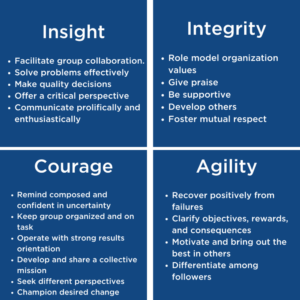Leadership Qualities Needed In Today’s Work Environment
As a leader, I challenge you to ask yourself if you know what qualities are needed to be successful? Can you answer questions like:
- Are you a humble leader?
- Are you an innovative leader?
- Are you creating a thriving workplace for your team?
Part 1: Being A Humble Leader
To be successful in these times, our organizations need more leaders modeling key qualities like humility. This article from the Wall Street Journal, The Best Bosses Are Humble Bosses, does a great job sharing why it’s so important.
Did you know that according to several recent studies, humble leaders inspire close teamwork, rapid learning, and high performance in their teams?
In this environment of constant change, ambiguity, and complexity we continuously ask our teams to learn rapidly and to be high performers. Being a humble leader helps them perform well.
Let’s stop for just a moment and reflect on this question. Who are leaders I know who display humility?
According to the research, humble leaders do the following:
- They tend to be aware of their weaknesses.
- Are eager to improve themselves.
- Appreciate others’ strengths.
- Focus on goals beyond their self-interest.
- Fly under the radar.
- Give credit to their teams.
- Ask for help.
- Listen to feedback from others.
- Show ethical behavior.
- Avoid manipulating others.
The impact of these leadership qualities on employees? Lower turnover and lower absenteeism.
Take a moment and ask yourself, “Am I a humble leader?”
Part 2: Innovative Leadership Qualities
Do you have the qualities of an innovative leader?
According to recent quantitative research reported by McKinsey, there are roughly 20 fundamental components of leadership that correlate closely to organizational performance.
Progressive leaders who demonstrate these components are better able to support change and innovation in their organizations.
McKinsey discovered in their research that four key leadership attributes help organizations stand out and move forward at a distinctive pace.
The four attributes are Insight, Integrity, Courage, and Agility.
- Insight helps leaders calibrate and see what matters in operations and with people.
- Integrity helps leaders build conviction and deep trust within the organization.
- Courage supports leaders in taking on important and challenging opportunities quickly.
- Agility helps leaders know when they need to change course and keep going.

Here are how the 20 research-supported traits integrate with the four leadership characteristics that are seen as essential for the future by the interviewees who participated in the research.
As you read through the list to the right, do a mental assessment as to how well you demonstrate each of these traits. Then pick one or two that you’d like to strengthen.
Use this tool to assess yourself on how well you are doing with the Four Leadership Attributes and the 20 traits. Consider asking your team and manager to give you feedback as well.
Part 3 – Creating a Thriving Workplace
Gallop’s State of the Global Workforce 2022 Report is a report committed to “bringing the voices of employees to the decision-making tables.”
So my question for you: As a leader, are you helping employees THRIVE?
In the report it states only 21% of workers report they are thriving at work. Only 21 percent!
So what’s causing this? It’s simple, employee BURNOUT.
According to Gallop the 5 main causes that relate to burnout include:
- Unfair treatment at work
- Unmanageable workloads
- Unclear communication from managers
- Lack of manager support
- Unreasonable time pressures
Can you relate? Not surprisingly the one thing all five causes have in common: The Boss! Bosses are so impactful that Gallop can predict 70% of the variance in team engagement just by getting to know the boss. Wow!
The good news? We can make a difference and change! Gallop states to have employees thrive – there are 6 things managers need to do consistently.
6 Things Managers Need To Do Consistently
- Help them learn and grow
- Recognize them for doing great work
- Listen
- Coach them
- Collaborate
- Make them feel truly cared about.
That sounds pretty refreshing to me! It’s not hard. It’s just different from what many managers are doing across the world.
I’ve worked with leaders who understand the importance of thriving cultures and want help getting there. I can tell you for those committed to learning, the results have been amazing. Not only more smiling, but more collaboration, more innovation, and better business outcomes.
What it takes for each of your direct reports to thrive, might look a little different. Think about each one of your direct reports, then make notes below to help you connect with each of them in a personal way. Use this tool to help you.
For the latest industry news and business tips and resources delivered right to your email inbox, subscribe to our Taking Care of Business Newsletter.
Subscribe
This blog was contributed by Dr. Rita Webster, founder of WiseLeader. WiseLeader is an executing coaching service with thoughtful leadership programming, such as Executive Coaching for Women, Next Level Leadership, Women’s Roundtables, Executive Team Coaching, Career and Transition Coaching. View the original blog here.
View Rita’s free on-demand discussion on imposter syndrome in the workplace here.
Watch Here



